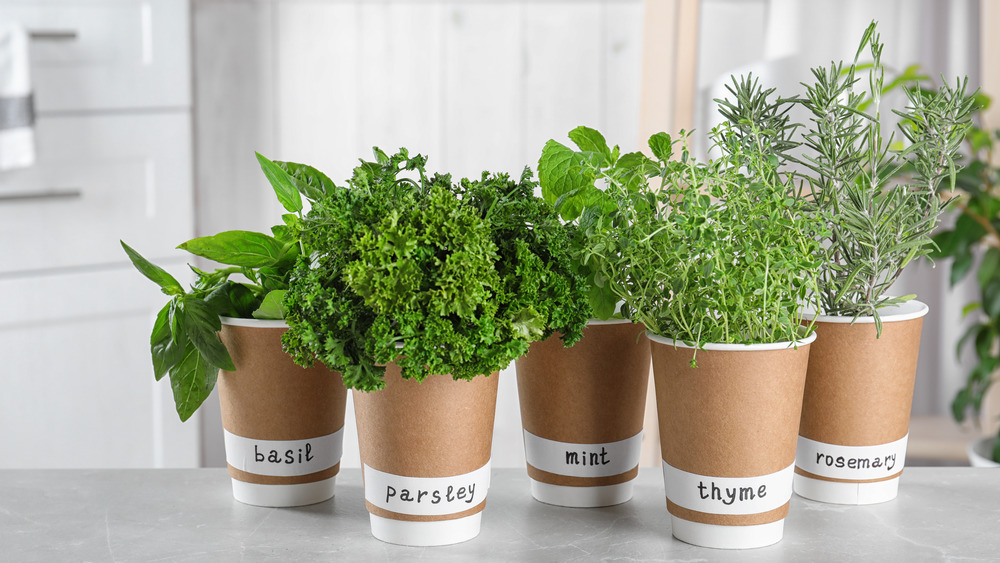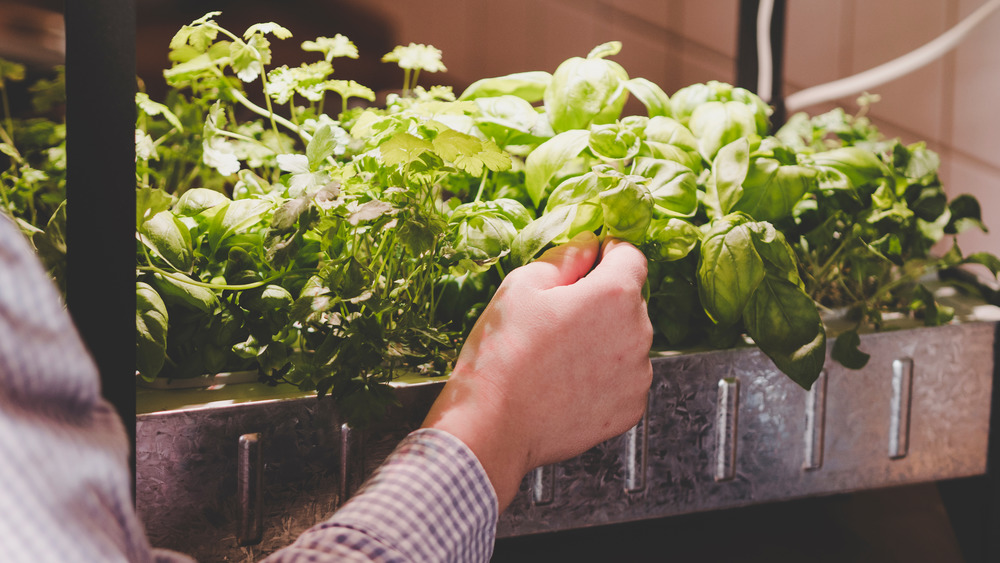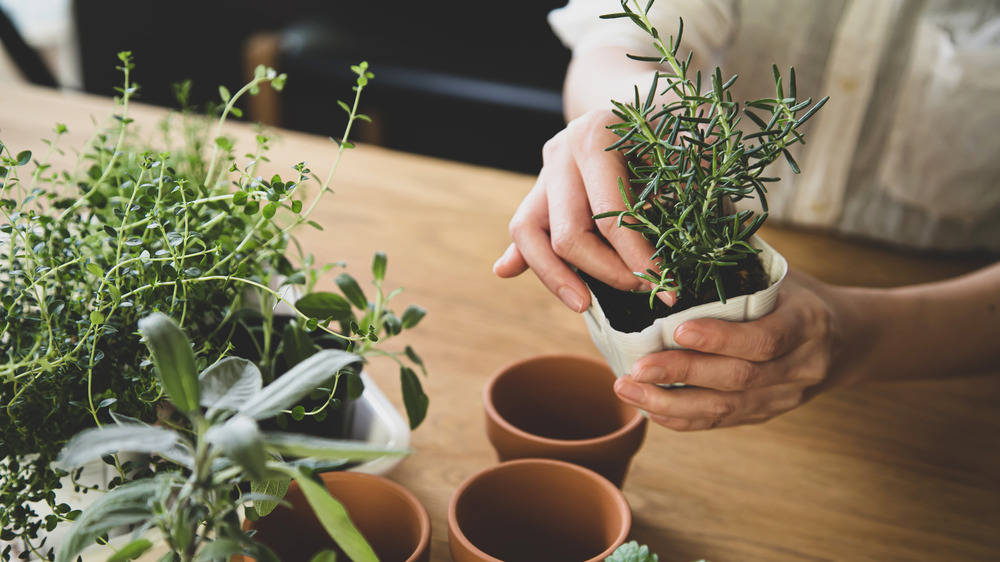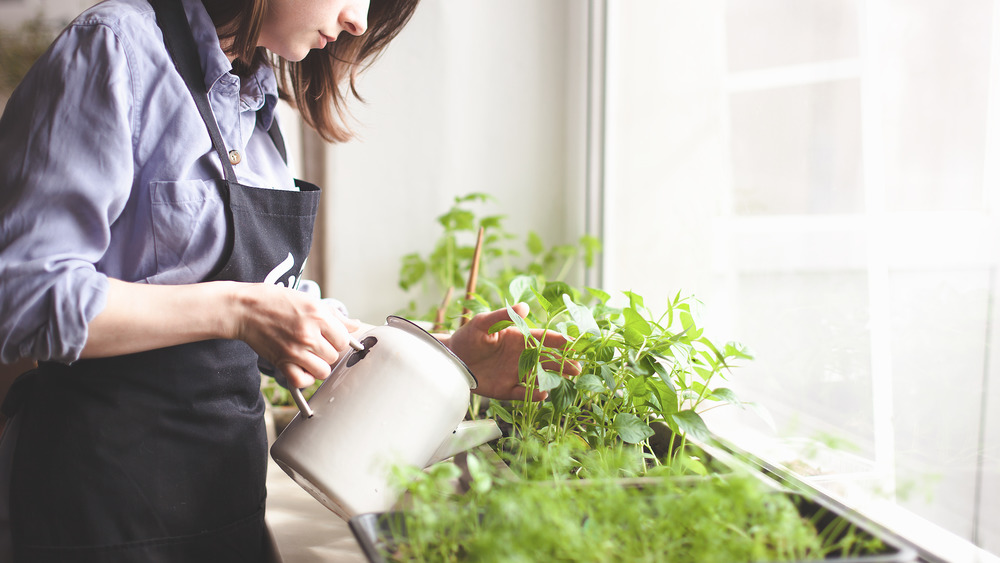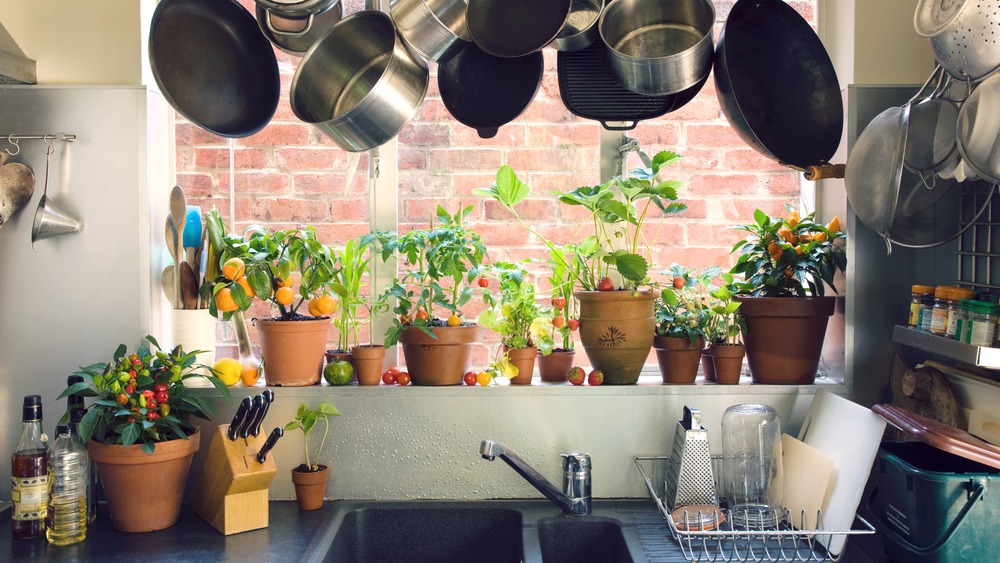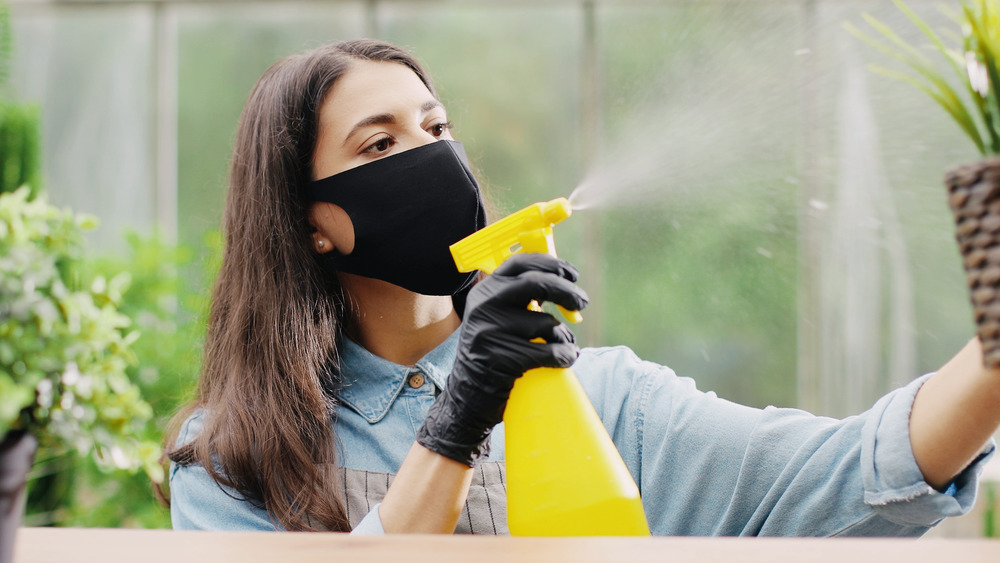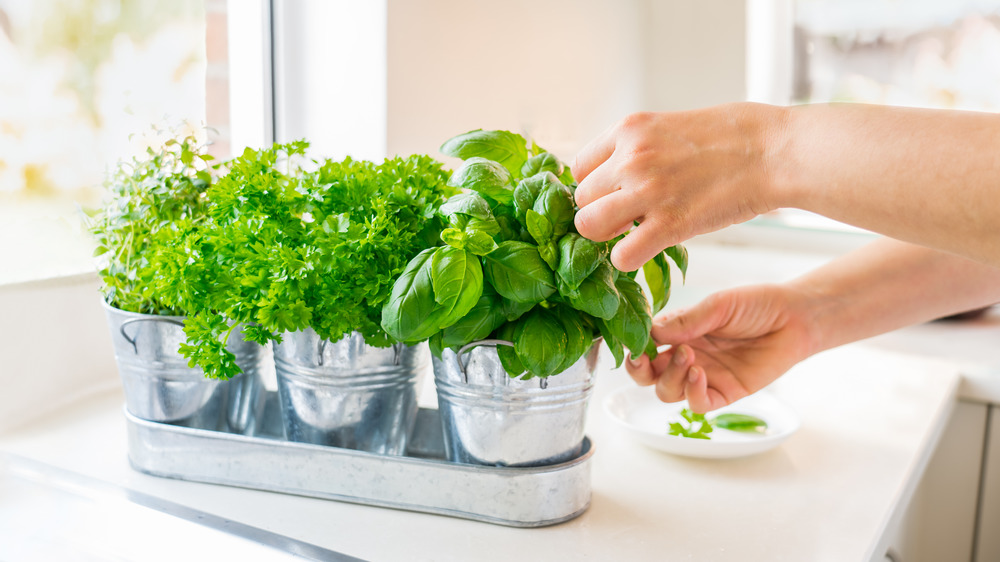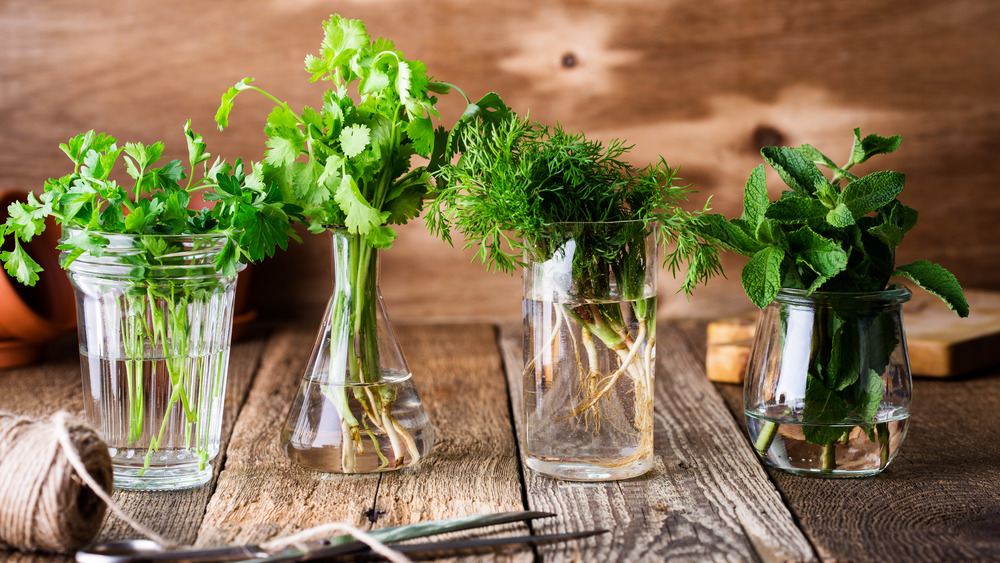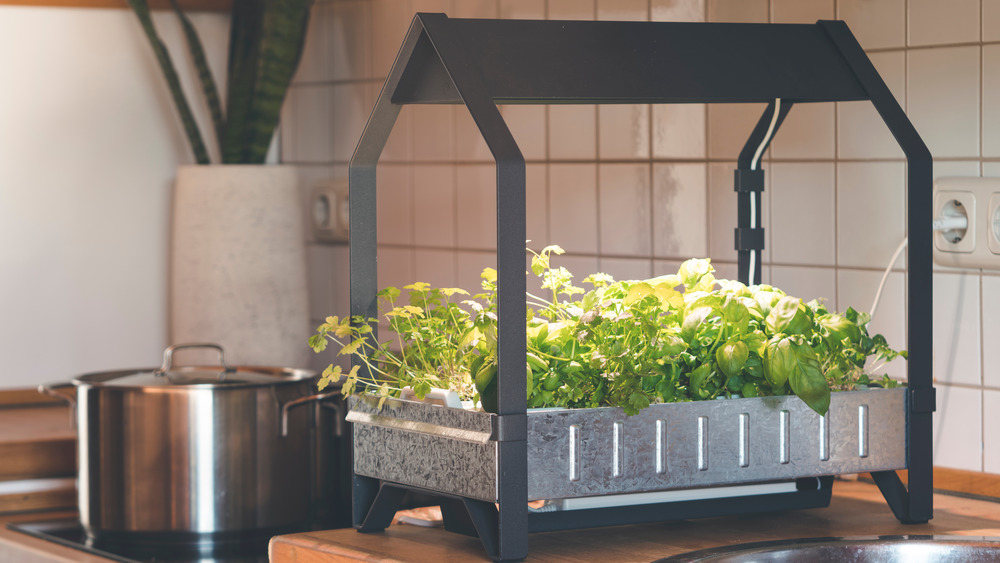Mistakes You Are Making With Your Kitchen Herb Garden
As people have spent an extended period of time at home this past year during the ongoing coronavirus pandemic, home cooking has become increasingly popular. At the same time, people are trying to limit trips to the grocery store, so it's difficult to stock up on fresh herbs. It can also get expensive very quickly.
Using fresh herbs is great, because they add amazing flavor to different foods, and can help bring a dish full-circle. They also make eating at home a little more special. They can kick your meals up a notch both in taste and presentation. Plus, when you're cooking, it's fun to head over to your adorable kitchen herb garden to cut off just what you need.
So grow your own herbs right on your kitchen windowsill, and add a bit of sunshine to each plate ... and hopefully your day as well.
But as many have tried to grow fresh herbs at home and failed, what mistakes are we making? We are here to help ensure you don't make the below mistakes in your own indoor garden.
Your herbs aren't getting enough sunlight
It cannot be stressed enough. Where you choose to grow your herb garden makes a huge difference on the quality of herbs produced. "When choosing your location, look for areas that have plenty of sunlight," Ed Wike of gardengrowguide.com tells Mashed. It's also a good idea to be near a water source, since herbs require lots of it.
"I had a herb garden in my kitchen for a short period, but was really bummed when it wasn't flourishing as much," Donna Bloss, the CMO at Thrive Cuisine, tells Mashed. At the time, Bloss was living in an apartment, so growing her own food was pretty limited. "I thought it would be simple. I spoke with a gardener friend one day and brought up the issue and he told me: Kitchen herb gardens need to be south facing. My kitchen was facing north," says Bloss. "I have now moved my herb garden to my living room which is south facing, and my herbs are growing wonderfully."
Indoor herb gardens don't need to be in your kitchen, although it is more convenient. Bloss says it best: "When you think about it though, you travel all the way to the store to buy your food, so why not a few feet into another room to cut off some fresh herbs for your favorite dishes!"
Also keep in mind how much sun your plants should receive. "Most herbs need at least a few hours of direct sun to thrive," says Rosie Leary, a horticulturalist and botanical data specialist with Candide Gardening. Signs that your indoor herb garden is not receiving enough light include poor growth, abnormally long stems between leaf sets, and leaves that are pale or have turned yellow. "The easiest way to make sure your herbs are getting enough light (especially during the winter months) is to place your plants under a grow light," says Amy Enfield, horticulturist for Bonnie Plants. These specialty lights mimic direct sunlight and is a great solution if your home is short on natural sunlight.
Your pots are overcrowded
Overcrowded pots are another mistake you may unknowingly be making. "My best advice is to harvest regularly to encourage bushy, new growth (this new, fresh growth is the tastiest!) and to sow frequently, so [you will always have] plants growing at different stages, like a little production line," Rosie Leary, a horticulturalist and botanical data specialist with Candide Gardening, tells Mashed.
If you plan to keep herbs in your indoor garden for more than a few weeks, make sure to select a container that gives them proper space to grow. According to Amy Enfield, horticulturist for Bonnie Plants, "For most herbs, a 6-inch container will work fine."
When selecting your container, make sure that it has drainage holes. (Herbs hate sitting in water which will cause their roots to rot.) To protect your tabletop or windowsill, make sure you also have a water collection tray to sit underneath your plant. "Containers that are glazed or made of plastic are ideal for growing herbs indoors. Clay or terra cotta pots tend to dry out quickly, especially in the winter," says Enfield.
You're giving your herbs too much or not enough water
In regards to watering, it's important that you don't overwater your herbs. "If your herbs have too much water, they can get white mold," Ed Wike of gardengrowguide.com tells Mashed. If you feel like you can't remember when you last watered them, use a soil moisture meter to ensure that your herbs are getting the correct amount of water.
Other people neglect their plants and don't water them enough ... or at all. According to Amy Enfield, horticulturist for Bonnie Plants, "The right way to water is somewhere in the middle."
Your herbs should be watered when the top inch of soil becomes dry. "The easiest way to test this is by gently sticking your finger into the soil either daily or every other day," says Enfield. If the soil still feels cool and damp, wait to water, but if the soil is dry, it's time to give your herbs a drink.
When you water your herbs, water thoroughly. "Saturate the soil and allow the excess water to drain away," says Enfield, who recommends removing any standing water in the water collection trays that remain 20 minutes after watering to prevent root rot.
You may want to water them every day, but most herbs will only want more water when you touch the top soil and it feels dry to the touch. "Instead of watering on a daily basis, feel the soil. If it feels dry, water your herbs. If the soil feels damp, hold off," Jen Stark, founder of Happy DIY Home, a leading gardening and home improvement blog, tells Mashed.
You're not using proper drainage
Drainage may not be something that's often considered, but think about it. You are regularly pouring water into a pot of soil. Does that water get absorbed? And if it isn't fully absorbed, where does that water go? Is it just pudding in the bottom of the pot? And what does that mean if it is? That's where drainage comes in. Another mistake home gardeners commonly make is not providing adequate drainage on their herb pot(s).
"A drainage pot comes equipped with dozens of tiny holes at the bottom of the base that allows excess water to leave the soil," Jen Stark, founder of Happy DIY Home, a leading gardening and home improvement blog, tells Mashed. You can pop the whole garden into the sink, water it until the water runs out of the bottom, and leave it to drain for 10-20 minutes, says Stark. Problem solved!
You're not using fertilizer
Using fertilizer is really important for having happy and healthy home plants. While plants need water, they also need food to grow healthy and strong, and fertilizer is that food. Of course, how much food and how often that food is needed will vary from plant to plant, so there may still be a bit of a learning curve or trial and error involved.
Once you are ready to buy fertilizer, make sure that the fertilizers you use are free from heavy metals and contain nutrients that help with your growth. "Opt for either seaweed extract which has high concentrations of nitrogen that help promote leaf growth," Zach Reece of Colony Roofers tells Mashed. Keep in mind that as your soil ages, you may need to add more fertilizer to keep the plant healthy.
You're not pruning your herbs regularly
Indoor herbs will require regular pruning to keep them healthy and full, and many people forego this. It also encourages faster growth. Pruning simply involves snipping off leaves and some parts of stems of your plants to help them thrive.
Pruning may sound complicated, but it's actually rather easy. "Get a smaller pair of pruning shears and prune your plants when you notice them getting leggy or sprawling out," Jen Stark, founder of Happy DIY Home, a leading gardening and home improvement blog, tells Mashed. If you can't use what you prune off right away, dry it and use it later. Then, just make it part of your plant routine, and you'll start to see the results.
You don't know each herb's specific needs
Here's a big mistake that rookie herb gardeners do that significantly decreases their herb garden's success: not knowing each herb's specific needs. Just like all people are different, all plants are different, too. "Each herb has different needs to survive, and giving them the same treatment means that some will die and some will survive," Marina Vaamonda, home improvement expert and founder of PropertyCashin, tells Mashed.
Many herb gardeners think that if they water their herb garden and give them sun exposure, it will be enough for their garden to flourish. However, that misconception can cause you to lose your garden. "If you want to turn this project into a long-term commitment, I suggest studying four things before planting a particular herb. Here they are: water requirements, sunlight requirements, fertilizer needs, and insect attracting or repelling qualities," says Vaamonda.
You didn't choose the right herbs to grow indoors
All herbs do well outside if provided with proper care (sunlight, soil, watering, and fertilizer). But, some herbs do better indoors than others. "Because of the reduced light levels indoors, herbs that grow well in partial sun outdoors are the best options to grow indoors," Amy Enfield, horticulturist for Bonnie Plants tells Mashed. According to Enfield, these include chives, lemon balm, mint, Greek oregano, parsley, French tarragon, and English thyme. "These herbs will last longer and won't be as 'leggy' (or stretched)," says Enfield.
In speaking with Enfield, we also learned that sage and rosemary are great herbs to grow inside if your home receives a lot of sunlight. If you don't have a lot of sun, stay away from dill, basil, cilantro, and chamomile. A grow light is an excellent idea, as every herb will benefit from that source of light inside.
